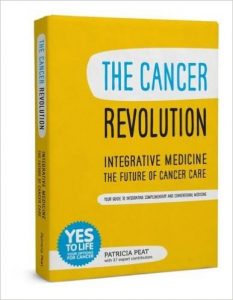 The Truth about Cancer by Ty M. Bollinger
The Truth about Cancer by Ty M. Bollinger
Reviewed by David Lorimer
 The Cancer Revolution – Integrative Medicine – the Future of Cancer Care: Your Guide to Integrating Complementary and Conventional Medicine by Patricia Peat and 37 expert contributors
The Cancer Revolution – Integrative Medicine – the Future of Cancer Care: Your Guide to Integrating Complementary and Conventional Medicine by Patricia Peat and 37 expert contributors
Reviewed by David Lorimer
The debate about cancer between conventional and complementary therapies is a highly politicised example of the underlying tension between naturopathic and allopathic or pharmaceutical approaches to health and medicine. It is a striking historical fact that 100 years ago, the incidence of cancer in the US was 1 in 80, and it is now nearer to 1 in 2 (moreover, costs of treatment in the US are now in the region of $200,000 a year). It is important to consider why and how this has happened, but also to understand the biological research background. On the one hand, we have the development of the germ theory of disease with Pasteur, and on the other the emphasis on what Antoine Bechamp called the ‘terrain’, which we would now call the internal ecosystem in which the disease arises. Germ theory on its own represents a reductionist mode, while taking into consideration the terrain as well embodies a holistic approach. In addition, the American medical system was fundamentally altered through the Flexner report of 1910, which encouraged the professionalisation of medicine and the development of conventional orthodoxy primarily based on drugs and surgery. This led to the rise of the pharmaceutical industry, which still dominates the profession, the journals and the regulatory authorities.
In his book, Bollinger tells the story of alternative approaches such as Rife, Hoxsey and Gerson being sidelined and suppressed in spite of promising and sometimes spectacular results. An important theoretical approach which is now finding more flavour is that cancer is primarily a metabolic rather than a genetic condition, a view championed by Paul Seeger and 1931 Nobel Prize winner Otto Warburg. He quotes Warburg as saying that ‘cancer has only one prime cause… The replacement of normal oxygen respiration of body cells by an anaerobic cell respiration.’ This is the result of a mitochondrial dysfunction characterised by damaged cellular metabolism where otherwise healthy cells switch to an anaerobic state and become cancerous. Interestingly, this process feeds on sugar, encouraging fermentation.
Critics of Bollinger’s book point to the confirmation bias inherent in his sample, and it is certainly true that complementary therapies are not uniformly successful. However, both these books stress the importance of prevention in terms of lifestyle factors including diet, detoxification and avoidance of environmental as well as electromagnetic toxins. Bollinger describes a large number of possible interventions with comments by practitioners and those who have benefited from them. Readers will need to exercise a certain caution and discrimination in any extrapolation from the case histories, even though the overall preventive strategies may be generally valid. The bottom line of his argument is that cancer need not be a death sentence, that conventional therapies may do more harm than good, and that there are many other avenues to consider.
The Cancer Revolution takes an altogether more measured and less confrontational stance, referring early on to integrative oncology, reflecting the role that an overall integrative approach can play within a range of possible treatments. Patricia Peat has a background as an oncological nurse, and began to notice the benefit to some of her patients through adopting alternative modalities. She is passionate about putting the patient in charge of the treatment process. The strength of this book lies in the expertise of the other 37 contributors as well as Patricia’s editorial skill. It is primarily aimed at patients, although carers and families can also benefit enormously from the content. Readers are given advice according to the stage and progression of the cancer, and there are a series of therapeutic targets mentioned throughout the book, such as pH balance, detoxification, oxygenation and immune stimulation.
Among the topics covered by a variety of contributors are types of therapy, detailed advice on diet and lifestyle, including exercise, water consumption, juicing, the value of raw food and means of managing stress. Readers are also given advice about how to handle consultations and hospital routines. Experts describe what their interventions can be expected to achieve, while the appendices give information on international clinics, scans and how to find appropriate practitioners. All this is given considerable careful thought with the reader very much in mind. The book is also beautifully produced. The relationship between conventional and complementary therapies is delicately handled, including potential tensions in courses of treatment where antioxidants may or may not play a constructive role, depending on the circumstances. Having said that, the book does make a strong case for integrating complementary approaches into the overall treatment, but that in itself cannot completely resolve the political tension between the approaches outlined above since one is fundamentally about the management of disease symptoms and the other the promotion of health and a resilient immune system.
